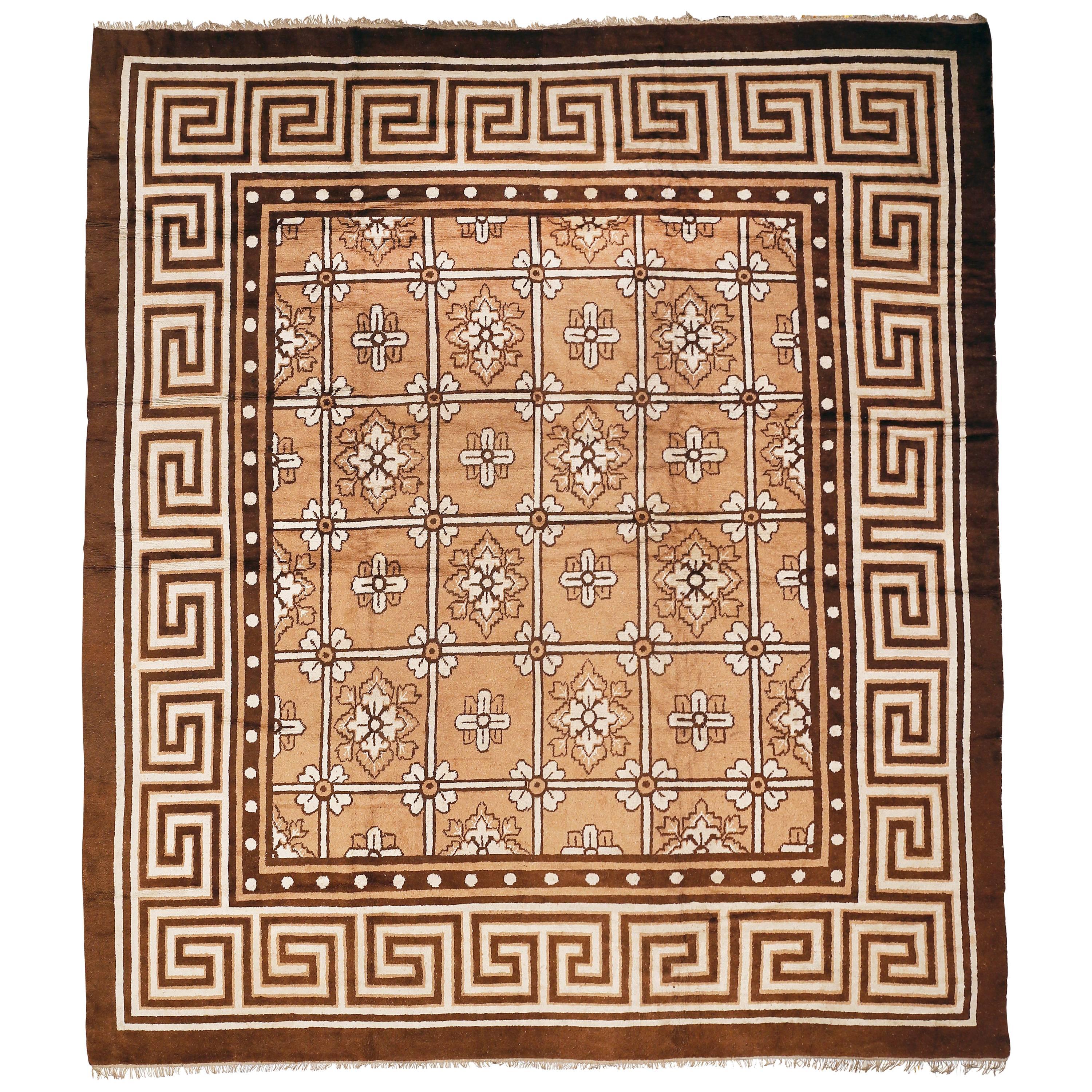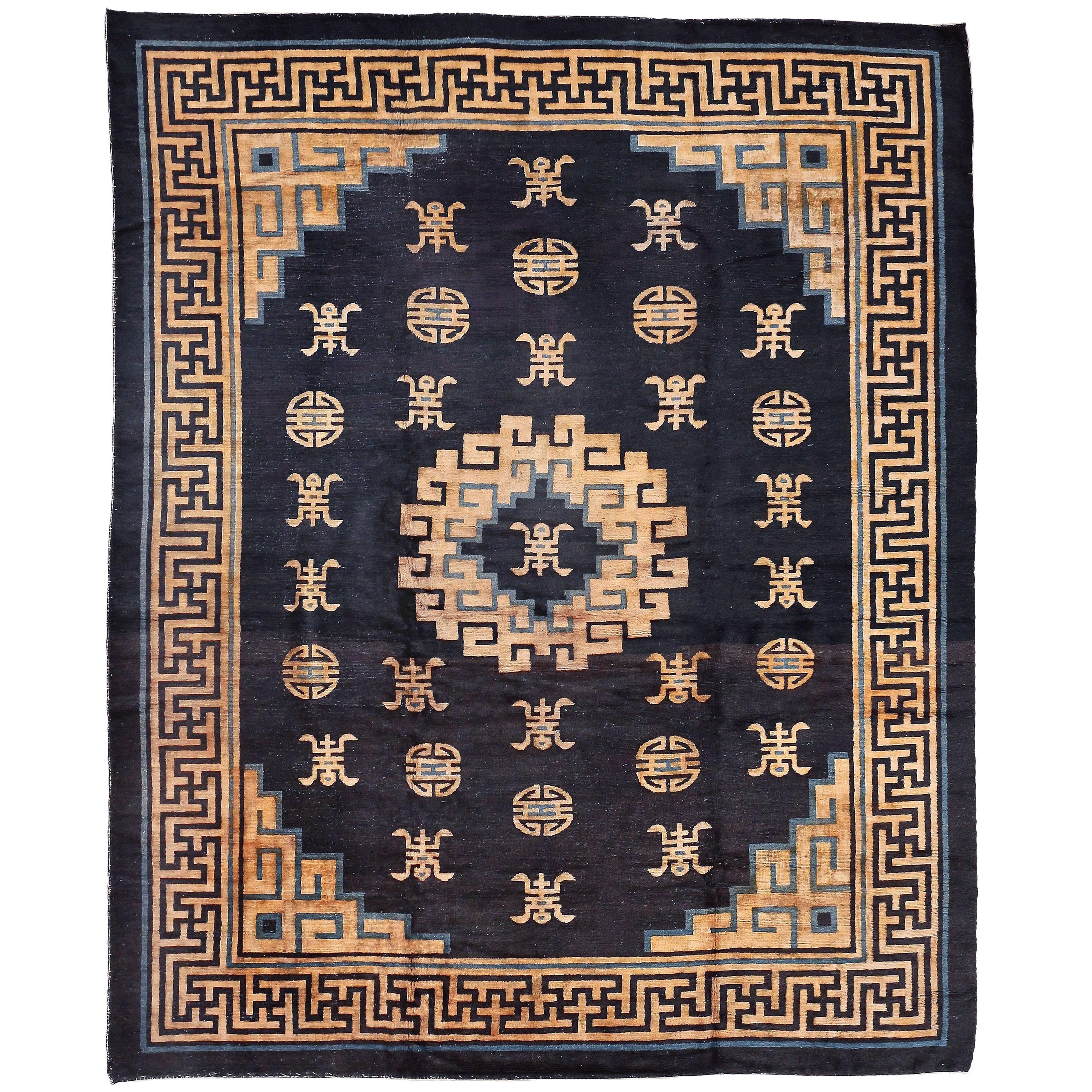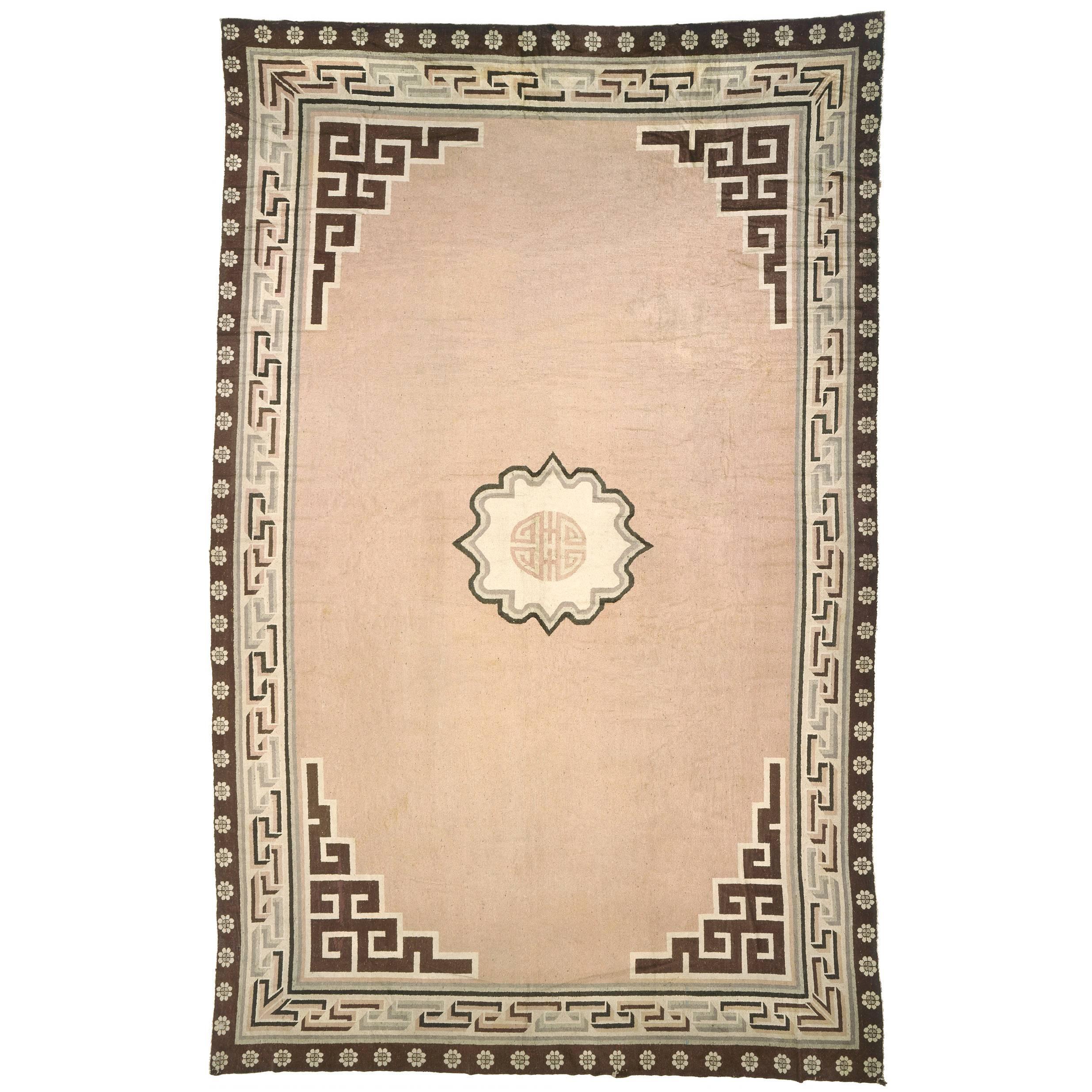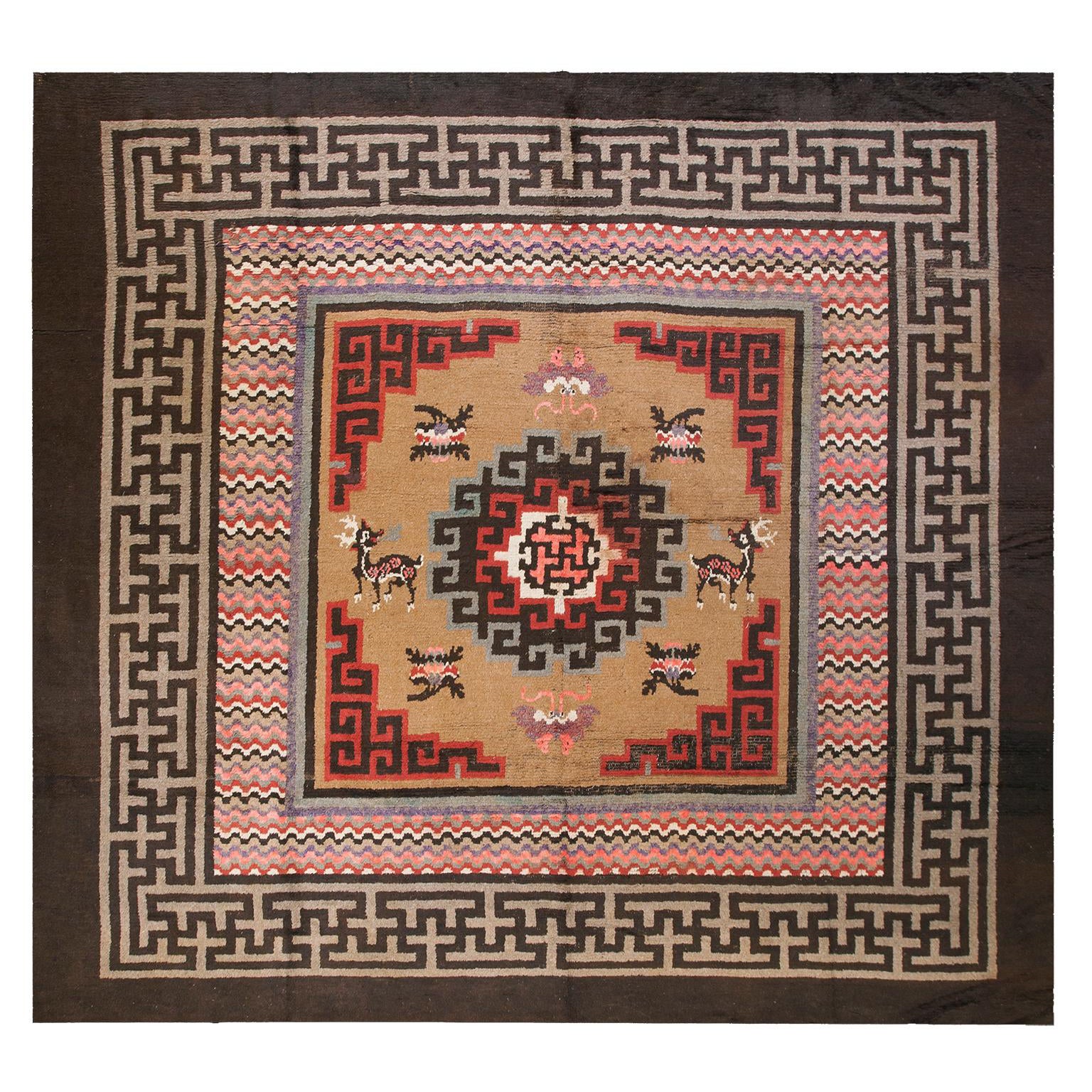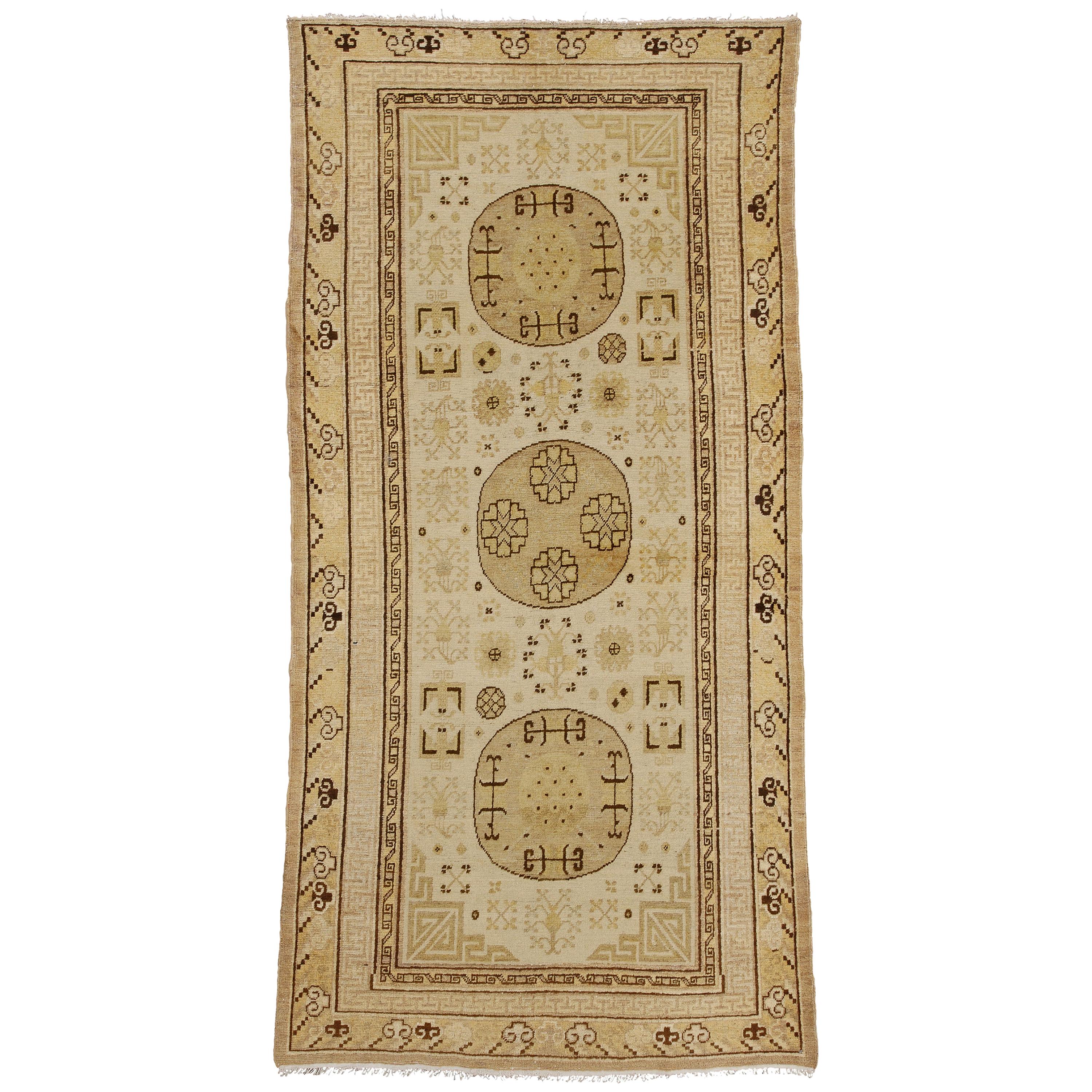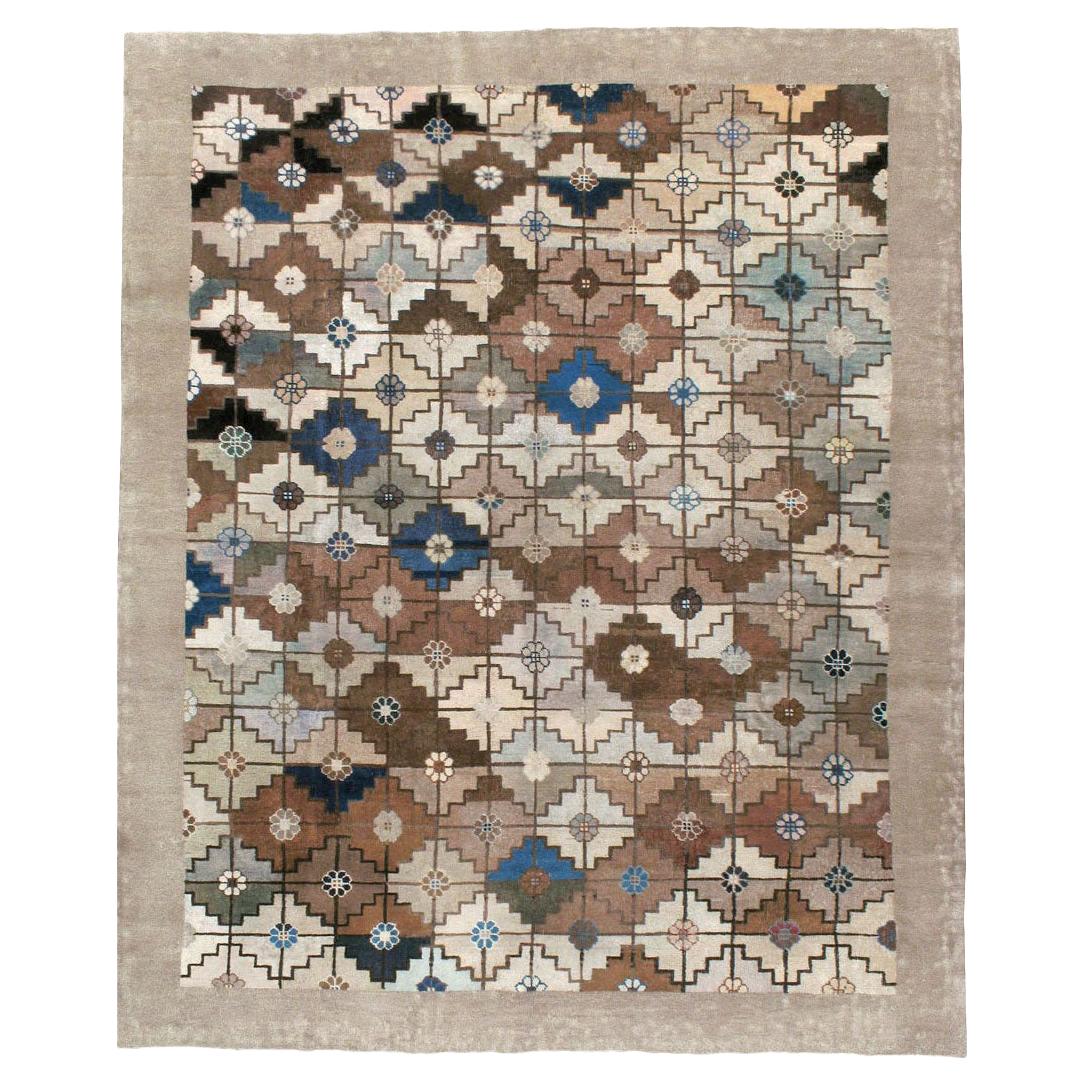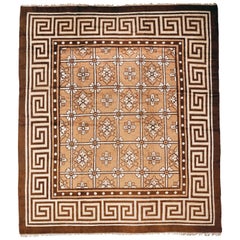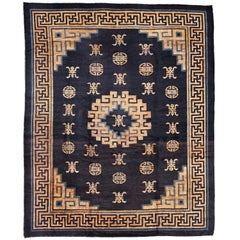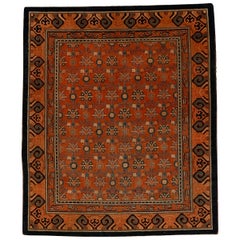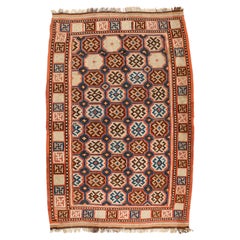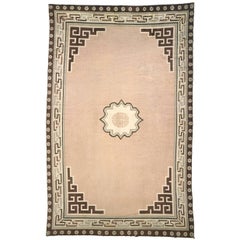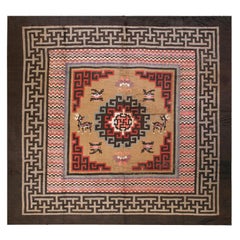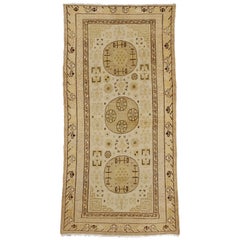Items Similar to Rare and Antique Geometric Ivory Mongolian Rug
Want more images or videos?
Request additional images or videos from the seller
1 of 7
Rare and Antique Geometric Ivory Mongolian Rug
$16,788.50
£12,488.95
€14,000
CA$22,989.20
A$25,560.87
CHF 13,346.48
MX$311,138
NOK 170,295.21
SEK 159,558.47
DKK 106,574.27
Shipping
Retrieving quote...The 1stDibs Promise:
Authenticity Guarantee,
Money-Back Guarantee,
24-Hour Cancellation
About the Item
Today Mongolian carpets are highly appreciated for the geometric character of their design and for their neutral palette, which is often centred on an ivory/dark colour combination. Here the geometric medallion and spandrels are balanced by a repeat pattern of stylised flowers alternated to butterflies. The composition is framed by a wide and powerful border ornated by large shou ideograms (Chinese symbols for long life) in its two versions.
- Dimensions:Width: 127.96 in (325 cm)Length: 135.83 in (345 cm)
- Style:Tibetan (Of the Period)
- Materials and Techniques:Wool,Hand-Knotted
- Place of Origin:
- Period:
- Date of Manufacture:circa 1850
- Condition:Repaired: Some of the oxidised charcoal wool has been repiled and there are scattered small reweaves. I will be happy to provide you with detailed pictures of all the repairs, which were done about 15-20 years ago. Wear consistent with age and use. The pile is uniformly low. It is nevertheless in very usable condition although perhaps not in a highly trafficked area.
- Seller Location:Milan, IT
- Reference Number:Seller: 002341stDibs: LU954921253582
About the Seller
5.0
Recognized Seller
These prestigious sellers are industry leaders and represent the highest echelon for item quality and design.
Gold Seller
Premium sellers maintaining a 4.3+ rating and 24-hour response times
Established in 1997
1stDibs seller since 2012
205 sales on 1stDibs
Typical response time: 1 hour
- ShippingRetrieving quote...Shipping from: Milan, Italy
- Return Policy
Authenticity Guarantee
In the unlikely event there’s an issue with an item’s authenticity, contact us within 1 year for a full refund. DetailsMoney-Back Guarantee
If your item is not as described, is damaged in transit, or does not arrive, contact us within 7 days for a full refund. Details24-Hour Cancellation
You have a 24-hour grace period in which to reconsider your purchase, with no questions asked.Vetted Professional Sellers
Our world-class sellers must adhere to strict standards for service and quality, maintaining the integrity of our listings.Price-Match Guarantee
If you find that a seller listed the same item for a lower price elsewhere, we’ll match it.Trusted Global Delivery
Our best-in-class carrier network provides specialized shipping options worldwide, including custom delivery.More From This Seller
View AllAntique Geometric Mongolian Chinese Rug
Located in Milan, IT
The geometric lattice scheme and the wide, almost three-dimensional Greek fret border that distinguishes this rare Mongolian carpet is clearly inspired from the early carpets of the ...
Category
Antique 1880s Mongolian Qing Chinese and East Asian Rugs
Materials
Wool
Antique Mongolian Chinese Carpet with Longevity Motifs
Located in Milan, IT
The rare carpets of Mongolia have in recent years achieved a stature of their own. They differ from traditional 19th century Chinese carpets in that they typically employ stylized pa...
Category
Antique 1870s Chinese Chinoiserie Chinese and East Asian Rugs
Materials
Wool
Rare and Unusual Antique Kashgar Rug with Mughal Pattern
Located in Milan, IT
A very rare small format, very finely knotted antique rug from the oasis of Kashgar, located in eastern Turkestan. Distinguished by a unique soft red background and by an all-over pattern consisting of a trellis containing a directional floral blossom motif characteristic of the Indian Mughal Dynasty...
Category
Antique Early 19th Century East Turkestani Ming Chinese and East Asian Rugs
Materials
Wool
Rare and Unusual Antique Khotan Kilim Rug
Located in Milan, IT
A rare and unusual flat woven cover from the Khotan oasis in eastern Turkestan, distinguished by a honeycomb arrangement of octagons containing polychrome stepped lozenges with hooked extensions. We see similar patterns in the early pile rugs of this region, especially in conjunction with the stylised Greek...
Category
Antique 1830s East Turkestani Khotan Chinese and East Asian Rugs
Materials
Wool
Antique Geometric Design Chinese Rug with Polychrome Diamonds
Located in Milan, IT
There is a group of later Chinese carpets which are characterized by geometric, often abstract patterns that seem inspired by Western sensibilities. What is puzzling however is that most of these weavings have been sourced in recent years in China itself, where they have been used in households ever since they were made. Whatever its origin, the resulting pattern of coloured lozenges has an outstanding three dimensional quality, and can be compared to the most important objects of twentieth century design.
Category
Early 20th Century Chinese Tibetan Chinese and East Asian Rugs
Materials
Wool
Vintage Caucasian Geometric All-Over Shield Design Sumak Rug
Located in Milan, IT
During the 1980's there was a great resurgence of interest towards antique weavings. This prompted many innovations in the development of contemporary carpets, paying close attention...
Category
Vintage 1980s Azerbaijani Sumak Caucasian Rugs
Materials
Wool
You May Also Like
Early 20th Century Mongolian Carpet
Located in New York, NY
Early 20th century Mongolian carpet.
Category
Early 20th Century Chinese Chinese and East Asian Rugs
Early 20th Century N. Chinese Mongolian Carpet ( 11'10" x 12'2" - 360 x 370 )
Located in New York, NY
Early 20th Century N. Chinese Mongolian Carpet ( 11'10" x 12'2" - 360 x 370 )
Category
Antique Early 1900s Chinese Chinese and East Asian Rugs
Materials
Wool
Early 20th Century Tibetan Khotan Rug
Located in New York, NY
Tibet, circa 1920
Handwoven.
Category
Early 20th Century Tibetan Tibetan Chinese and East Asian Rugs
Materials
Wool
Early 20th Century Handmade Mongolian Art Deco Style Room Size Carpet In Neutral
Located in New York, NY
An antique Mongolian room size carpet handmade during the early 20th century with a contemporary Art Deco style geometric pattern in neutral colors.
Measures: 9' 2" x 11' 1"
The craft of the hand-knotted carpet in China, and the surrounding areas including Mongolia and Tibet, extends into the early centuries of the first millennium, C.E., but we really have a firm grasp only beginning in the later 16th century with large, very coarsely woven carpets, often depicting dragons, created for the Imperial Forbidden City palaces. Chinese carpets have always been commercial and there are no tribal groups responsible for any of the carpet weaving strains.
When the Ming Dynasty fell in 1644, with no Imperial patrons, production moved to the city of Ningxia in north central China where several workshops turned out more finely woven pieces for the Mandarins of the administrative Ch’ing bureaucracy and well-to-do merchants. Ningxia was the major Chinese carpet center up through most of the 19th century, with first allover and then medallion designs on cotton foundations in medium weaves. Palettes were initially limited to yellows, dark blue and cream, but later widened to include reds, browns and even green. These antiques were the first Chinese carpets to be exported to the West and they fitted in well with the craze for Chinese blue-and-white porcelain in the second half of the 19th century. Ningxia also wove shaped and rectangular small rugs for saddle underlays, chair (“throne”) seats and shaped backs, pillar carpets with dragons or monks for Buddhist monasteries, and long divided runners for monastery meditation halls. These small rugs are among the most collectible of all Chinese weavings.
Weavers from Ningxia set up workshops in the capital Peking (Beijing) in the 1860’s and began weaving Western room sizes for export, primarily to America. In blue – and – white and polychrome palettes, with round wreath medallions, precious objects, seasonal flowers, paeonies, lotuses, fretwork, clouds, butterflies and bats, all relatively spaciously drawn. The round “Shou” (Good Luck) character is also a prominent decorative motif. There are also a few Peking landscape pictorials with pagodas, houses, bridges, waterscapes and boats. Peking carpets were woven right up until WWII and production began again after the Cultural Revolution around 1970. They are moderately well-woven, on cotton foundations, exactingly executed and indisputably Chinese. Many are in the blue-and-white style. Nothing else looks like a Peking carpet and for a Chinese “look” in a room, they are absolutely indispensable. Sizes range from scatters and a few runners, through the popular 9’12’ size, to large carpets over 20’ which must have been special orders. The earliest Peking Revival carpets are pliable and fairly thin, but they became heavier and more compact in the 20th century, in competition with Art Deco carpets from Tientsin. The modern, post- 1970, pieces are in the traditional Peking style, but are a little too regular and neat. Exactitude has been favored over character, as hard to explain that as it is.
There are a number of all-silk and silk-and –metal thread pieces, many with inscriptions purporting to link them with rooms in the Imperial palaces, bringing very substantial auction prices, but none are really antique. The genre emerged after WWI and the present demand comes from mainland Chinese. The silk piles often stand in pattern relief against flat woven gold metal thread grounds. The inscriptions are apocryphal, the rugs are flashily opulent, perfect for nouveaux riches.
The Art Deco period between the two World Wars saw a distinctive carpet industry developing in Tientsin (Tianjin) in northeastern China. These are highly prized for their transitional design character, neither overtly Chinese, nor abstractly modern/contemporary. Woven exclusively for export, usually by and for American firms, such as Nichols and Elbrook, they are totally in the “Jazz Age Modern” style of the 1920’s, often without borders, with abstract or abstracted patterns, and only with, at best, a few Chinese-y pattern elements. Vases asymmetrically placed in the corners are features of some of the more Chinese-y carpets. Open fields with floral sprays and branches growing in from the edges are anther design innovation. Often, Chinese motives have been re-imagined in more sharp-edged, abstract manners. Some have no references whatsoever to natural elements. The patterns are sharp and the rugs are never subdued, soft or restrained. The rugs are heavily constructed, with crisp, unfading dyes and medium to medium coarse weaves on cotton foundations. All are extremely well-executed, with none of the vagaries, variations or twists found on even high-quality Persian rugs. The majority are in the 9’ by 12’ format and a surprising number can be found in top condition. There also was a substantial production in Peking from, especially from the Fette factory. Elliptical and round carpets, and lighter, often pastel colors, were a specialty. Nothing looks like an Art Deco Chinese and they work well with traditional Chinese furniture and the most modern decor as well. These is no substitute for a good Chinese Art Deco carpet.
Chinese carpets also include small scatters from Tibet, with high quality wool, floating dragons and allover textile patterns. The colors of vintage and modern pieces are bright, but there are antique small rugs (sleeping rugs) with simple chessboard allovers. Only a few large antique Tibetan carpets...
Category
Early 20th Century Mongolian Art Deco Chinese and East Asian Rugs
Materials
Wool
Mid 19th Century Geometric Chinese Rug
Located in New York, NY
A mid 19th Century Geometric Chinese Accent Size Rug
Measures: 3'7'' x 5'11''.
Category
Antique Mid-19th Century Chinese Export Chinese and East Asian Rugs
Materials
Wool
19th Century Mongolian Carpet
Located in Dallas, TX
Chocolate, cream, yellow and white surrounded by a blue stripe.
Stylized motifs adorn the wide cream border surrounded by an edge of chocolate.
Category
Antique 19th Century Mongolian Central Asian Rugs
More Ways To Browse
Mongolia Antique
Antique Mongolian Furniture
Rugs Mongolia
Mongolia Carpet
Mongolian Antique
Antique Mongolian Rug
American Art Deco Rug
Art Deco Dragon Rug
Antique Chinese Orange Rug
Antique Tibetan Carpet
Antique Tibetan Rugs
Antique Tibetan Carpets And Rugs
Chinese Art Deco Rug Purple
Red Dragon Rug
1920s Nichols Rugs
Antique Chinese Pictorial Rug
Mongolia Antique
Round Rug Chinese
